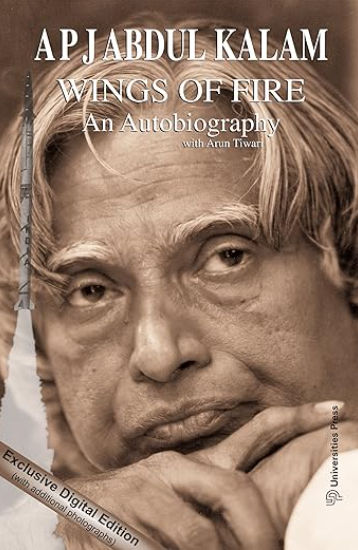The Story of “Wings of Fire Summary” revolves around a life of APJ Abdul Kalam, a simple living man from Tamil Nadu, who changed Indian Space System with his inventions and hard work.
Wings of Fire By APJ Abdul Kalam

Synopsis of Wings of Fire ( Autobiography )
The story of “Wings of Fire” centres around a life of Abdul Kalam’s life, starting with their birth, Kalam was born on 15th October 1931 in a Muslim family from a village of Rameshwaram, Tamil Nadu. Kalam full name is “Avul Pakir Jainulabdeen Abdul Kalam”. Kalam’s father, Jainulabdeen was an owner of small boat who used to work as ferry. Kalam’s mother name is “Ashiamma Jainulabiddin”. Abdul Kalam was the youngest son of his family. Kalam had one elder sister and three elder brothers. Kalam did his high schooling from Schwartz High School. Kalam was a very intelligent boy since his school days.
Abdul Kalam did his graduation in BSC. Physics from St. Joseph’s College, Tiruchirappalli. As Kalam wasn’t satisfied with his BSC degree, he decided to pursue Engineering from Madras Institute of Technology. There was a decommissioned aircraft in Madras Institute which inspired Kalam to fly high in life. Inspired by aircraft, Kalam chooses Aeronautical Engineering in his second year of college. Kalam applied for two jobs right after his graduation.
Abdul Kalam first interview was for a role of Directorate of Technical Development and Production (DTD & P) in Delhi. Second interview was for a role of Indian Air Force in which only top 8 people were selected while Kalam was in 9th rank rejected by just one rank. Disappointed Kalam goes in Rishikesh where he met Shivanand Swami. Abdul tells his rejection story to Sivananda Swami. Swami encourages Kalam by telling “Accept your rejections and moves forward in life”. Afterwards, Kalam goes in Delhi as he was shortlisted for “DTD” and got a job as Senior scientist.
As a Senior scientist Kalam first task was to create a hovercraft. It was a very challenging role as Kalam wasn’t experienced but chosen as a leader of his team. Kalam was given 18 months to build hovercraft project, but he builds it in only 15 months. Kalam named his hovercraft project as “Nandi”.
There comes professor, M.G.K Menon, a member of “INCOSPAR” who met Kalam during a testing of “Nandi”. As Nandi testing was successful, Menon invited Kalam for an opportunity in “INCOSPAR”. After three days of Nandi Testing, Kalam received interview call letter from a chief of INCOSPAR. Afterwards, Kalam was interviewed by Dr. Vikram Sarabhai, a chief of INCOSPAR. Kalam successfully cracked his interview and become a member of INCOSPAR team.
The full form of “INCOSPAR” is Indian Committee for Space Research which is currently known by name Indian Space Research Organization (ISRO). In INCOSPAR, Kalam first mission was TERLS (Thumba Equatorial Rocket Launching Station) in which space scientist were assigned to create a launching station through which their team can launch any rocket easily.
In a mission of TERLS, Abdul Kalam had three responsibilities, first was to design launching station, second was an integration of rocket and third was to keep a safety measure of station. For a testing of Thumba Station, “Nike Apache” rocket was used which was imported from foreign country. The rocket “Nike Apache” was successfully launched on 21st November 1963. As TERLS rocket launching was successful, Vikram Sarabhai, a chief of INCOSPAR invited Abdul Kalam for a personal meeting. Vikram shared his dream to Kalam about having India’s own rocket launching station with Indian SLV and Indian Satellite. He encourages Kalam to pursue his dream as he had a potential to achieve it.
Abdul Kalam got new mission in life which is to follow Vikram’s dream and build India’s own rocket launching station with India’s own SLV and India’s own Satellite. Kalam had one special talent which is Technology Observation and Absorption. Vikram sends Kalam in NASA Langley Research Centre to research on SLV (Satellite Launch Vehicle). There Kalam saw an inspiring painting of Tipu Sultan who is attacking on Britishers through Rocket Technology.
On 15th August 1968, ISRO was established and superseded INCOSPAR. ISRO scientists were divided into two parts where few scientists are assigned to a development of SLV while few are allocated to a development of “ROHINI” satellite. Furthermore, Abdul Kalam returns from NASA, he was assigned to a designing of SLV fourth stage. Finally, the day of SLV testing comes, Kalam was very happy because he has developed SLV without any foreign technology.
As Kalam with his team launching their first SLV, he received a “STOP” message on his computer screen due to which they had to stop SLV testing immediately. Afterwards, Kalam tried again but this time he faced biggest setback as SLV stage 1 was cleared but during SLV stage 2 testing it blasted like a bomb. Abdul Kalam was a man of perseverance, he tried again and this time it became historical as on date, 28th July 1980, SLV was launched successfully, and it established “ROHINI” satellite successfully on low earth orbit.
RECOMMENDED READING